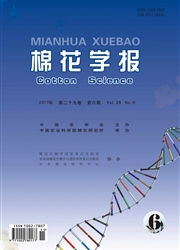

 中文摘要:
中文摘要:
在南京(长江流域下游棉区)和徐州(黄河流域黄淮棉区)设置氮素水平(零氮:N0kg·hm^-2适氮:N240kg·hm^-2,高氮:N480kg·hm^-2)试验,研究了氮素对棉铃(伏桃、秋桃)干物质积累分配和纤维品质性状的影响。结果表明:棉铃各组成部分的干物质积累以纤维受氮素的影响最大,其次为棉子、铃壳。棉子与纤维间存在同步异速生长关系,这种关系可用模型y=a+bx表示(x、y分别代表棉子、纤维干重的自然对数,a为截距,b为线性回归系数)。零氮、高氮处理均降低了伏桃的b值,相应的纤维比强度亦显著降低;秋桃的b值在适氮与高氮处理间差异较小,但显著高于零氮处理,纤维长度、比强度及整齐度对氮素水平的响应亦呈现出相同趋势。综合分析认为,棉子、纤维异速生长方程的线性回归系数b越大越有利于高品质棉的形成。
 英文摘要:
英文摘要:
To investigated the effects of nitrogen rates on dry matter accumulation and distribution of boils and fiber quality characteristics,field experiments were conducted in Nanjing (middle lower reaches of Yangtze River Valley) and Xuzhou (Yellow River Valley). The three N rates is 0,240 and 480 kg· hm^-2, standing for low, optimum and high nitrogen application level, respectively. The results showed that the effect degree of nitrogen rates on fiber was higher than that on seed or fiber. The decrease in seed/fiber ratio came from an allometric growth between seed and fiber, which could be expressed by the following equation: y=a+bx(x is the natural logarithm of cottonseed and y is the natural logarithm of fiber dry weight per boll, a is intercept and b is regression coefficient for the linear equation). "b" of the cotton bolls bloomed on Jul 25 was significantly declined under low-nitrogen or high-nitrogen treatment, fiber strength also decreased correspondingly. " b" of the cotton bolls bloomed on Sep 10 has a little difference between high-nitrogen treatment and medium-nitrogen treatment, but significantly higher than low-nitrogen treatment, and the indices of fiber length, strength and uniformity showed similar trends too. All the results indicated that the larger "b" is,the more favorable to form high fiber quality.
 同期刊论文项目
同期刊论文项目
 同项目期刊论文
同项目期刊论文
 Effects of N fertilization on root development and activity of water-stressed cotton (Gossypium hirs
Effects of N fertilization on root development and activity of water-stressed cotton (Gossypium hirs Physiological Mechanism of Sucrose Metabolism in Cotton Fiber and Fiber Strength Regulated by Nitrog
Physiological Mechanism of Sucrose Metabolism in Cotton Fiber and Fiber Strength Regulated by Nitrog Modeling boll maturation period, seed growth, protein, and oil content of cotton (Gossypium hirsutum
Modeling boll maturation period, seed growth, protein, and oil content of cotton (Gossypium hirsutum 期刊信息
期刊信息
